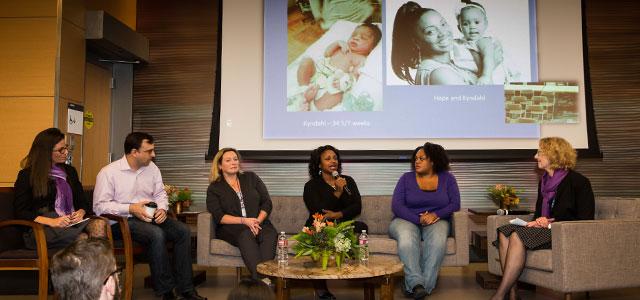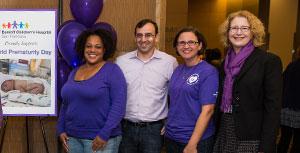
Linda Franck (far right) moderates a panel on community-driven research. From left to right: parent Brittany Lothe, parent Scott Bolick, nurse Robin Bisgaard, parent Hope Williams and parent Schyneida Williams (photo by Elisabeth Fall).
California Initiative Aims to Dramatically Reduce Preterm Birth, Improve Outcomes
In 2015, when a group of some 60 UC San Francisco researchers and clinicians sat down to tackle the epidemic of preterm birth, the lives of 15 million children were at stake.
That’s how many children are born premature (before 37 weeks’ gestation) each year worldwide. One million die within the first 28 days of life, and preterm birth is the largest killer of children under 5. Those infants who do survive are at considerably increased risk for a lifetime of health challenges – from neurological disorders to obesity, hypertension and diabetes. Yet despite the devastating impact – which disproportionately affects disadvantaged communities – in recent years there has been little improvement in slowing the rate of preterm birth.
Fortified by a $100 million promise from philanthropists Lynne and Marc Benioff and the Bill & Melinda Gates Foundation, the UCSF team spent a year planning its effort. Team members cast a wide net and focused intently on forging collaborations and listening closely to other health systems, community leaders, educators, civic officials and, most important, women in disadvantaged communities who have experienced or are at risk for preterm birth.
As the year progressed, the group split into two separate but coordinated initiatives, with the Gates Foundation funding the UCSF Preterm Birth Initiative East Africa (PTBi-EA) and the Benioffs funding the UCSF Preterm Birth Initiative California (PTBi-CA). Both groups have created ambitious five-year plans that involve research to make new discoveries as well as to more effectively implement existing best practices for preventing and treating preterm birth.
“In California, our long-term goal is to eliminate the disparities in care that lead to dramatically different rates of prematurity – and to improve the outcomes of babies born preterm,” says UCSF School of Nursing’s Linda Franck, who is co-principal investigator for PTBi-CA and the Jack and Elaine Koehn Endowed Chair in Pediatric Nursing.
How PTBi-CA arrived at its plan and what that plan entails present a case study in blending humility and hubris to tackle an enormously complex public health challenge.
A Focus on Toxic Stress
Early on, the group recognized that research investments on preterm birth are skewed toward rescuing mothers and preterm babies rather than adequately addressing the roots of the problem, which extend long before birth or even pregnancy.
“Without getting at the roots, it’s difficult to move the needle, especially since few standard treatments are effective at preventing preterm birth,” says UCSF School of Medicine’s Larry Rand, the Lynne and Marc Benioff Endowed Chair in Maternal Fetal Medicine and principal investigator for PTBi-CA.
With this in mind, the team turned to UCSF epidemiologist Laura Jelliffe-Pawlowski, now associate director for precision health in PTBi-CA. With her team, Jelliffe-Pawlowski began digging into patterns of preterm birth in three locations that will be the primary focus for PTBi-CA: San Francisco, Oakland and Fresno County. These data demonstrated that if you’re poor or African American, you’re at considerably higher risk of preterm birth. A woman living in San Francisco’s Bayview-Hunters Point is nearly three times more likely to have a preterm birth than a woman living in the much wealthier Presidio. As demonstrated by related map, more than 40 percent of Fresno’s preterm births occur in about a 2- by 5-mile historically poor sector of the city.
Women in these communities often experience pervasive racism, increased exposure to violence, environmental contamination, a dearth of safe places to live and exercise, and poor access to transportation and healthy food. This leads to toxic levels of emotional and biological stress, which put these women at risk not only for preterm birth, but also for a litany of chronic diseases that exacerbate the risk of preterm birth.
 Live Births (California Vital Statistics Birth Statistical Master Files 2011-2013): In Fresno, more than 40 percent of all preterm births were concentrated in about a 2- by 5-mile area. In San Francisco, more than one in six of all preterm births were in the Bayview/Candlestick/Portola/Visitacion Valley areas.
Live Births (California Vital Statistics Birth Statistical Master Files 2011-2013): In Fresno, more than 40 percent of all preterm births were concentrated in about a 2- by 5-mile area. In San Francisco, more than one in six of all preterm births were in the Bayview/Candlestick/Portola/Visitacion Valley areas.
“Preterm birth is fundamentally related to stress, but it is not a simple, linear pathway,” says Franck.
Understanding and addressing stress – and its supposed antidote, resiliency – became one of PTBi-CA’s central organizing principles. UCSF School of Nursing’s Monica McLemore, PTBi-CA’s associate director for community-engaged research and a former preemie herself, is already conducting an independent study of 210 African American women in Oakland that will measure stress, resilience and coping at five points during these women’s pregnancies. The group has also enlisted other experts from across UCSF – including Nancy Adler, Elissa Epel and Tom Boyce – to spark new ways of looking at how stress affects pregnancy and birth.
“Yet even if we did an amazing job of reducing the rate of prematurity, we still need to deal with postnatal care for preemies to help guard against the stresses they face,” says Rand.
He notes, for example, that skin-to-skin contact between the mother and her newborn is often a better way to maintain body temperature than putting preterm infants in incubators. “Brain development [between the two warming methods] is night and day, and a lot of it has to do with a massive reduction in stress,” he says. “These newborn babies recognize something they know [their mother’s smell and heartbeat], and they’re put at ease – their heart rate, breathing rate, become more stable.”
Understanding how to optimize this effect is a perfect example of how the five-year plan combines clinical research with systems-based research to shift existing practices to more evidence-based approaches.
Patient as Partner
As another organizing principle of PTBi-CA – true partnership with affected women and communities – took shape, it helped clarify and deepen the focus on toxic stress even as it shone a light on important concerns that have historically gone un- or underexplored.
Early interviews with women from communities with high rates of preterm birth led to composite vignettes that highlighted the stressors and resiliency factors that women felt most strongly affected their health and that of their babies.
 Larry Rand, Laura Jelliffe-Pawlowski, Monica McLemore Franck and McLemore then took the community-engagement strategy one step further and proposed that women at high risk for preterm birth be asked directly what research questions were most important to them. After adapting a European methodology that had never been applied in the US, the two researchers held focus groups that included women of color being served by two community organizations: Black Infant Health and Homeless Prenatal Program.
Larry Rand, Laura Jelliffe-Pawlowski, Monica McLemore Franck and McLemore then took the community-engagement strategy one step further and proposed that women at high risk for preterm birth be asked directly what research questions were most important to them. After adapting a European methodology that had never been applied in the US, the two researchers held focus groups that included women of color being served by two community organizations: Black Infant Health and Homeless Prenatal Program.
“We wanted women affected by preterm birth to have a voice…to tell us what unanswered questions they had about their pregnancies and births in the context of family, work, life, birth and the health care system. We wanted to be very transparent and humble that science and health care don’t have all the answers,” says McLemore. “The success of these sessions speaks in part to the trust people have for nurses; it was also helpful that I’m a woman of color and I work at the General [Zuckerberg San Francisco General Hospital and Trauma Center]. I wasn’t a foreign face.”
“People want to do community-engaged research, but too often the engagement happens after the questions are set,” says Franck. “We wanted our research agenda to reflect the priorities of patients, families and communities as much as [those] of researchers and our funders.”
Rand adds that true partnership also means asking and listening to what women say they want in return for participating in the PTBi – or any research-based project. “If we can provide things like child care during prenatal appointments, or an accessible community through group prenatal care, then people seem much more willing to help,” he says.
What no one fully anticipated was that the women in these first groups would generate more than 100 unique research questions, including far-reaching policy questions that could affect prenatal care, inpatient care and regulatory and workplace concerns. Their insights and the way these women humanized the initiative’s many challenges have had an enormous influence on the resulting five-year plan.
Testing New Methods of Prenatal Care
Prenatal care, of course, plays a critical role in preterm birth – and in many ways, these women found the current methods don’t adequately serve their needs.
“They wanted to know about the evidence for the typical 10-visit prescription for pregnant women,” says McLemore. “Which of the appointments is safe to skip becomes an important question when it is difficult to leave a job or find child care.”
“The thing is, we made up the current US model of prenatal care,” says Rand. “Women come in and wait in a waiting room. If you have two jobs – or don’t have a job – there are so many obstacles to participating in this process. Do they really need to come in just to check their blood pressure? What if they knew how or could do it for a neighbor or friend?”
Rand says group prenatal appointments, like CenteringPregnancy, are really a community skills-building lab – and a worthwhile investment in this regard.
“It’s not hard to teach someone how to take blood pressure, and once they start, they suddenly care about blood pressure permanently,” he says. “If you are young, in your 20s, and not sick yet, this is learning important health behaviors that can change everything. The return on investment is indescribable.” Numerous clinical trials of the CenteringPregnancy model have demonstrated benefits, from decreased risk of preterm birth through long-term health improvements.
Examining Interactions with the Health Care Community
As they discussed prenatal care, the women also turned an important lens on their interactions with the health care system. “One woman told about her preterm labor at five months and how she was looking for the health care team to believe in her – and how hard it was when they didn’t,” says McLemore.
That story led to other women talking about failures in communication, disrespect and an unwillingness on the part of their providers to explain interventions. They wanted more research on ways to improve patient-provider communication, particularly when patients perceive insensitive and rude comments from health care workers. Those perceptions can make it difficult for women to fully partner with providers to optimize the women’s health and well-being.
One of the women said: “When you do your research or see a patient, think of my face.… We are more than a 15-minute prenatal appointment. We are people. That’s my baby; that’s my life.”
“Hearing some of this was very painful,” says McLemore, who noted how the negative interactions with providers multiply the toxic risk these women experience.
 Talita Oseguera, Norlissa Cooper “Too often, [for providers] pregnancy is seen as a disability or an ailment,” says Talita Oseguera, a doula and incoming student in the School’s nurse-midwifery program. “A lot of times, there’s a hierarchy, with the patient on one level, the white coat on another. Where we can improve is recognizing the pregnant person is the expert on their experience of pregnancy and their life.”
Talita Oseguera, Norlissa Cooper “Too often, [for providers] pregnancy is seen as a disability or an ailment,” says Talita Oseguera, a doula and incoming student in the School’s nurse-midwifery program. “A lot of times, there’s a hierarchy, with the patient on one level, the white coat on another. Where we can improve is recognizing the pregnant person is the expert on their experience of pregnancy and their life.”
“One of the participants – I fell in love with her transcript – talked about the stigma of being a drug user during pregnancy; it really impacted how she could connect with her provider,” says Norlissa Cooper, a PhD student at the School of Nursing who also works as a nurse at Zuckerberg San Francisco General Hospital. She decided her dissertation would focus on how health care providers determine to drug screen women at the time of delivery.
“Drug screens disproportionately impact people of color,” says Cooper. “These screens are sometimes done without the mother’s consent, and this fractures the relationship with the provider…which doesn’t just impact the mother, but also how the children develop relationships with the health care system going forward.”
Providers also constantly tell women at risk for preterm birth to manage their stress, but Oseguera says that the suggestions to relieve stress are not always easy for women to access. “Some of us can’t go for a massage or do a spa day for ourselves, so we need to identify what in our lives we can actually do to relieve our stress,” she says. “That can mean building community or trying to locate culturally sensitive mental health services.” She believes providers should be trained to help in this process.
“We also need to do more to empower the parents,” says Rand. “We can’t change food insecurity or poverty, but we can give parents a different sense of how to help themselves. That changes the stress level.”
“We know babies do better when parents are actively involved and that parents need lots of support to do this, but the health care system is still largely built around the professionals, with families treated as visitors,” says Franck. “Our research will need to test systems changes that can turn what we know into what we do.”
Developing Better Tools and Treatments
Both arms of the initiative also examined existing diagnostic technology and treatments available to help at-risk mothers and preterm infants.
“What we found – which is sort of shocking – is that we have lousy tools for measuring many of the factors we think are important predictors of preterm birth,” says Franck. “Not just the many manifestations of stress, but also the onset of labor or the temperature of a very preterm baby.”
That’s why Rand and others are working on wearable sensors and gathering data to create better predictive models for preterm birth, which can help improve clinician and patient decisionmaking.
McLemore says, “If you have a wearable monitor that transmits to the provider wirelessly, you don’t have to worry about travel, child care, time away from work. It breaks down a structural barrier.”
Moving Ahead with a Plan
 Linda Franck (far right) with “preemie” parent advisors, left to right, Schyneida Williams, Scott Bolick and Anne Shamiyeh (photo by Elisabeth Fall) After a year of listening and learning, the PTBi-CA team committed to a fully transdisciplinary and community/patient-centered plan that combines research with rapid testing and implementation of known best practices that rarely make their way into underserved communities. UCSF faculty members have already begun partnering with government agencies and community groups to launch a series of evidence-based programs, beginning in Fresno and using a strategy called “Collective Impact.”
Linda Franck (far right) with “preemie” parent advisors, left to right, Schyneida Williams, Scott Bolick and Anne Shamiyeh (photo by Elisabeth Fall) After a year of listening and learning, the PTBi-CA team committed to a fully transdisciplinary and community/patient-centered plan that combines research with rapid testing and implementation of known best practices that rarely make their way into underserved communities. UCSF faculty members have already begun partnering with government agencies and community groups to launch a series of evidence-based programs, beginning in Fresno and using a strategy called “Collective Impact.”
The PTBi-CA team expects that their plan will address the entire continuum, from preconception health concerns of women in their childbearing years through prenatal care, birth, and postpartum and postnatal care.
In addition, the plan emphasizes passing along what’s been learned through a three-pronged approach called C3, which involves an intensive communication effort, collaboration among stakeholders and capacity building among those best positioned to make change. The capacity building aims to create a new generation of researchers, clinicians, policymakers and advocates who can implement discoveries that emerge from PTBi. A flagship element is a PTBi Postdoctoral Fellowship Program, where people from different disciplines and backgrounds train together.
Will It Work?
It’s an exciting, even revolutionary project, but it remains to be seen whether it will significantly change outcomes. The team is well aware it could be a bumpy ride, but, says McLemore, “The long view is that this is a huge opportunity to explore big ideas and disrupt research as it currently exists to make some fundamental change in preterm birth outcomes.”
“We’ll make mistakes – overshoot sometimes, or be too cautious – but that’s what’s exciting,” says Franck. “Thanks to the vision of our funders, we have the support to be able to do bold, transformative experiments and create a new model of research that could be applicable to any big health problem.”
Whatever the challenges, the team vows to stay closely connected to the mission that brought them together – and to the needs of those most touched by this epidemic. “Preterm birth has directly affected my immediate family and close circle of friends,” says Oseguera. “I’m invested and hoping to continue to grow and learn, so I can be a part of the solution, too.”
“To this day, when my mother and I talk about her birth experience and me as a preemie, she still has PTSD,” says McLemore. “She still feels that weight, and I wonder: Is that the best we can do?”



